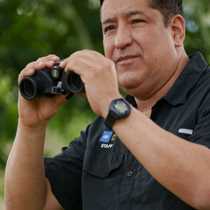Cedro Caño, Flor de Castaña & Belluda Caño
On this week’s expedition we have aboard an eager and enthusiastic group from the New York Yacht Club. In high spirits we went to explore very early in the morning “Cedro Caño,” a small but beautiful tributary of the Ucayali River. Some guests opted to go kayaking while others took a skiff ride instead. The morning was almost perfect for it was not hot yet and many different bird species were seen in a very pleasant climate. Equipped with cameras, binoculars, and a lot patience we searched for wildlife along the river edges and on the lush green tall walls of vegetation.
One of the highlights of the morning was the sighting of the smallest monkey species of the world, the Pygmy Marmoset (Cebuella pygmaea). These tiny monkeys are mainly detected by voice; they have as an alarm a characteristic soft and raspy chirping call. These tawny yellow-gray monkeys are diurnal, arboreal and can be found in groups of 2-9 individuals. Today we observed just one sitting on a branch moving constantly here and there. They feed mainly on saps or tree exudates making little holes with their minuscule but powerful jaws.
After a plentiful breakfast we went to visit ¬“Flor de Castaña” community. In this colorful location we had a great intercultural connection with their inhabitants for we had plenty of time to observe the villagers carrying on their normal daily activities. Our visitors observed with interest and respect the skills of some of the villagers that were cooking the most widespread staple food in the Amazon, the starchy root known as “yucca,” “manioc,” or “cassava” (Manihot esculenta). The best part of this visit, for many of us, was the pleasant time we had while we were in front of many of the local children and had the chance to sing some songs together with them. Our guests sang well-known songs in English that the children tried to follow, and they sang a couple of songs in Spanish that were sung along as well making this moment an amusing one.
In the afternoon, with the sun shining its most, we visited the third location of the day, Belluda Caño and its surroundings. We boarded our trustful fleet of skiffs to explore this remote and mysterious black water creek.
The highlight of this afternoon’s exploration, in addition to the many tropical bird species we saw, was the sighting of many monkey troops. Mammals are, in general terms, difficult to see in the rain forests but today we were fortunate to spot several species of them. We saw Squirrel monkeys (Saimiri sciureus), Saddle backed Tamarins (Saguinus fuscicollis) and Monk Saki monkeys (Phitecia monachus). We spotted several caiman lizards (Norops fuscoauratus) resting on the trees as well. This lizard species resembles a caiman alligator therefore its peculiar common name is very appropriate.
Late in the afternoon with company of the last sun rays of the day we came aboard with our minds and hearts filled with all the new memories and feelings that only the mighty Amazon can evoke.




